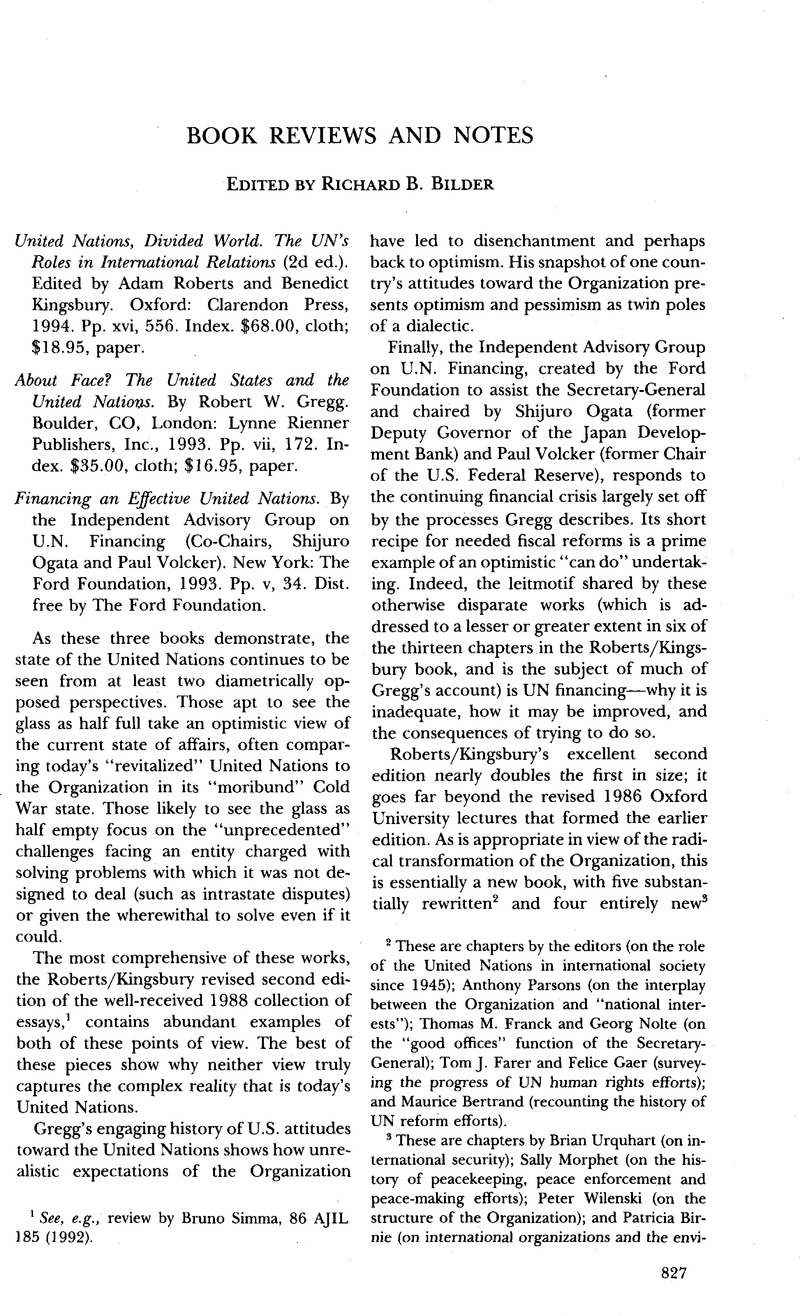No CrossRef data available.
Article contents
United Nations, Divided World. The UN’s Roles in International Relations (2d ed.). Edited by Adam Roberts and Benedict Kingsbury. Oxford: Clarendon Press, 1994. Pp. xvi, 556. Index. $68.00, cloth; $18.95, paper. - About Face? The United States and the United Nations. By Robert W. Gregg. Boulder, CO, London: Lynne Rienner Publishers, Inc., 1993. Pp. vii, 172. Index. $35.00, cloth; $16.95, paper. - Financing an Effective United Nations. By the Independent Advisory Group on U.N. Financing (Co-Chairs, Shijuro Ogata and Paul Volcker). New York: The Ford Foundation, 1993. Pp. v, 34. Dist. free by The Ford Foundation.
Published online by Cambridge University Press: 27 February 2017
Abstract

- Type
- Book Reviews and Notes
- Information
- Copyright
- Copyright © American Society of International Law 1994
References
1 See, e.g., review by Bruno Simma, 86 AJIL 185 (1992).
2 These are chapters by the editors (on the role of the United Nations in international society since 1945); Anthony Parsons (on the interplay between the Organization and “national interests”); Thomas M. Franck and Georg Nolte (on the “good offices” function of the Secretary-General); Tom J. Farer and Felice Gaer (surveying the progress of UN human rights efforts); and Maurice Bertrand (recounting the history of UN reform efforts).
3 These are chapters by Brian Urquhart (on in ternational security); Sally Morphet (on the history of peacekeeping, peace enforcement and peace-making efforts); Peter Wilenski (on the structure of the Organization); and Patricia Birnie (on international organizations and the environment). Most other chapters in the original edition have been retained, either unchanged or with only minor modifications.
4 Adam Roberts, The United Nations and International Security, 35 Survival 3 (1993).
5 See, e.g., Inis L. Claude, Jr., Collective Legitimization as a Political Function of the United Nations, 20 Int’l Org. 367 (1966); Thomas M. Franck, The Power of Legitimacy Among Nations (1990) (esp. ch. 7).
6 Nor does Morphet adequately explain why she believes that “[peacekeeping and election-monitoring are often best conducted in tandem” (p. 237). For a more comprehensive treatment of the complexities of the UN role in election assistance, see, e.g., Jon M. Ebersole, The United Nations’ Response to Requests for Assistance in Electoral Matters, 33 Va. J. Int’l L. 91 (1992).
7 See, e.g., U.S. Dep’t of State Press Release, The Clinton Administration’s Policy on Reforming Multilateral Peace Operations (May 1994) (on file with author).
8 Cf. John MacKinlay & Jarat Chopra, A Draft Concept of Second Generation Multilateral Operations 27–30 (1993) (citing specific UN Charter provisions).
9 Compare Maurice Bertrand, who suggests that UN ineffectiveness with respect to these is sues is based at least partly on major powers’ decisions to rely on the IMF and the World Bank to the detriment of UN economic and social activities (pp. 432–34) with Peter Wilenski, who writes more optimistically that changes in the workings of ECOSOC and UNCTAD may herald improvements in UN impact on policy making on economic development (pp. 460–64).
10 See, e.g., Application of the Convention on the Prevention and Punishment of the Crime of Genocide, Provisional Measures, 1993 ICJ Rep.325 (Order of Sept. 13).
11 For a thought-provoking take on this subject, see Christoph Schreuer, The Waning of the Sovereign State: Towards a New Paradigm for International Law?, 4 Eur. J. Int’l L. 447 (1993).
12 See, e.g., The United States and Multilateral Institutions (Margaret P. Karns & Karen A. Mingst eds., 1990); Thomas M. Franck, Nation Against Nation (1985); Daniel Patrick Moynihan, A Dangerous Place (1978); Jeffrey Laurenti, American Public Opinion and the United Nations (1992); Allan Gerson, The Kirkpatrick Mission: Diplomacy Without Apology: America at the United Nations, 1981–1985 (1991); Robert E. Riggs, US/UN: Foreign Policy and International Organization (1971). For a more recent presentation of the “mainstream” U.S. views toward the Organization, see United States Commission on Improving The Effectiveness of the United Nations, Defining Purpose: The U.N. and the Health of Nations (1993).
13 See, e.g., Franck, supra note 12 (esp. ch. 1, “Great Expectations”).
14 Gregg defines this as a tendency to see the world, especially as regards foreign policy, in bipolar terms—as a contest between forces of good and evil.
15 See Foreign Relations Authorization Act Fiscal Years 1994 and 1995, Pub. L. No. 103-236, §§102(g), 401(a), 108 Stat. 382 (1994).
16 According to Table III, the United States (in 1991), with a $304.45-billion total military spending and $151 million in peacekeeping assessments, had a ratio of 2,016:1. Ethiopia, the most extreme case, had, in 1991, a ratio of 182,485:1.
17 Supra note 7.




